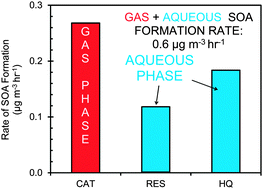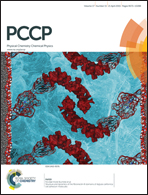Aqueous benzene-diols react with an organic triplet excited state and hydroxyl radical to form secondary organic aerosol†
Abstract
Chemical processing in atmospheric aqueous phases, such as cloud and fog drops, can play a significant role in the production and evolution of secondary organic aerosol (SOA). In this work we examine aqueous SOA production via the oxidation of benzene-diols (dihydroxy-benzenes) by the triplet excited state of 3,4-dimethoxybenzaldehyde, 3DMB*, and by hydroxyl radical, ˙OH. Reactions of the three benzene-diols (catechol (CAT), resorcinol (RES) and hydroquinone (HQ)) with 3DMB* or ˙OH proceed rapidly, with rate constants near diffusion-controlled values. The two oxidants exhibit different behaviors with pH, with rate constants for 3DMB* increasing as pH decreases from pH 5 to 2, while rate constants with ˙OH decrease in more acidic solutions. Mass yields of SOA were near 100% for all three benzene-diols with both oxidants. We also examined the reactivity of atmospherically relevant mixtures of phenols and benzene-diols in the presence of 3DMB*. We find that the kinetics of phenol and benzene-diol loss, and the production of SOA mass, in mixtures are generally consistent with rate constants determined in experiments containing a single phenol or benzene-diol. Combining our aqueous kinetic and SOA mass yield data with previously published gas-phase data, we estimate a total SOA production rate from benzene-diol oxidation in a foggy area with significant wood combustion to be nearly 0.6 μg mair−3 h−1, with approximately half from the aqueous oxidation of resorcinol and hydroquinone, and half from the gas-phase oxidation of catechol.


 Please wait while we load your content...
Please wait while we load your content...